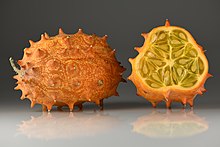Loading AI tools
Vine in the cucumber and melon family From Wikipedia, the free encyclopedia
Cucumis metuliferus commonly called the African horned cucumber (shortened to horned cucumber), horned melon, spiked melon, jelly melon, or kiwano, is an annual vine in the cucumber and melon family Cucurbitaceae. Its fruit has horn-like spines, hence the name "horned melon". The ripe fruit has orange skin and lime-green, jelly-like flesh. C. metuliferus is native to Southern Africa,[3][4] in South Africa, Namibia, Botswana, Zambia, Malawi, Zimbabwe, Mozambique, and Angola.
| Horned melon | |
|---|---|
 | |
| Cucumis metuliferus fruits | |
| Scientific classification | |
| Kingdom: | Plantae |
| Clade: | Tracheophytes |
| Clade: | Angiosperms |
| Clade: | Eudicots |
| Clade: | Rosids |
| Order: | Cucurbitales |
| Family: | Cucurbitaceae |
| Genus: | Cucumis |
| Species: | C. metuliferus |
| Binomial name | |
| Cucumis metuliferus | |
| Nutritional value per 100 g (3.5 oz) | |||||||||||||||||||||||||||||||||||||||||||||||
|---|---|---|---|---|---|---|---|---|---|---|---|---|---|---|---|---|---|---|---|---|---|---|---|---|---|---|---|---|---|---|---|---|---|---|---|---|---|---|---|---|---|---|---|---|---|---|---|
| Energy | 183 kJ (44 kcal) | ||||||||||||||||||||||||||||||||||||||||||||||
7.56 g | |||||||||||||||||||||||||||||||||||||||||||||||
1.26 g | |||||||||||||||||||||||||||||||||||||||||||||||
1.78 g | |||||||||||||||||||||||||||||||||||||||||||||||
| |||||||||||||||||||||||||||||||||||||||||||||||
| Other constituents | Quantity | ||||||||||||||||||||||||||||||||||||||||||||||
| Water | 88.97 g | ||||||||||||||||||||||||||||||||||||||||||||||
| †Percentages estimated using US recommendations for adults,[1] except for potassium, which is estimated based on expert recommendation from the National Academies.[2] | |||||||||||||||||||||||||||||||||||||||||||||||
Kiwano is a traditional food plant in Africa. Along with the gemsbok cucumber (Acanthosicyos naudinianus) and tsamma (citron melon), it is one of the few sources of water during the dry season in the Kalahari Desert.[5][6] In northern Zimbabwe, it is called gaka or gakachika,[7] and is primarily used as a snack or salad, and rarely for decoration. It can be eaten at any stage of ripening.
C. metuliferus may be used as a rootstock (via grafting) for melon to prevent both growth reduction and a strong nematode buildup in M. incognita-infested soil.[8]
The fruit's taste has been compared to a combination of banana and passionfruit,[9] cucumber and zucchini[4] or a combination of banana, cucumber and lime.[10] A small amount of salt or sugar can increase the flavor, but the seed content can make eating the fruit less convenient than many common fruits.
Some also eat the peel, which is very rich in vitamin C and dietary fiber.[11]
Germination is optimal between 20 and 35°C. Germination is delayed at 12°C, totally inhibits at seed stratification, and greatly inhibits above 35°C. Salinity increases the time required for full germination. The sowing dates greatly influence fruit yield and flowering.[12]
Kiwano is resistant to several root-knot nematodes; two accessions were found to be highly resistant to watermelon mosaic virus, but very sensitive to the squash mosaic virus. Some accessions were found to succumb to Fusarium wilt. Resistance to greenhouse whitefly was reported. Kiwano was reported to be resistant to powdery mildew, but in Israel, powdery mildew and squash mosaic virus attacked kiwano fields and control measures had to be taken.[13]
During 28 days of development on the plant, fresh weight, electrical conductivity and titratable acidity of fruits do not change, pH rises and then falls, and concentrations of reducing sugars and total soluble solids increases. In the same period, peel colour changes from green through whitish green to yellow and finally to orange, and the pigment profile shows a decline in pigments absorbing at 431 and 663 nm, and a rapid increase in those absorbing at 442 and 470 nm.[14]
Seamless Wikipedia browsing. On steroids.
Every time you click a link to Wikipedia, Wiktionary or Wikiquote in your browser's search results, it will show the modern Wikiwand interface.
Wikiwand extension is a five stars, simple, with minimum permission required to keep your browsing private, safe and transparent.